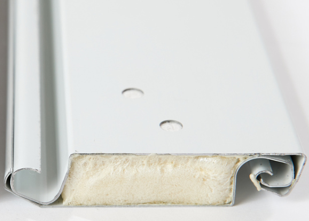Polyurethane is the Best Insulation for Rolling Doors
When investing in thermal efficiency, you want a rolling door that saves you the most amount of money while easily maintaining and regulating the temperatures inside of your building. That's why we're going to deep-dive into what polyurethane insulation is, how it outperforms polystyrene insulation of the same thickness and why you should invest in a thermal efficient rolling door for your commercial or industrial application.
Don't miss our detailed comparison of polyurethane and polystyrene insulation to help you choose the right insulation for your rolling steel door!
WHAT IS POLYURETHANE INSULATION?
Polyurethane is a high-performance insulation material commonly found in commercial and industrial products such as rolling steel doors. When installed inside of a rolling steel door, the foam is sprayed into place and expands to fill the entire area inside of each slat. Polyurethane insulation makes air pockets a thing of the past and creates greater environmental separation between the inside and outside of your building. For this reason alone, polyurethane, foam-in-place, insulation outperforms other insulation types commonly found in this industry, such as polystyrene.
WHY IS POLYURETHANE INSULATION SO IMPORTANT?
Investing in the right insulation for your rolling door is important because it's directly responsible for the level of climate control, product protection, energy efficiency and sound transmission that you experience.
It's no secret that energy-efficient doors provide significant savings by reducing your energy consumption. The greater that thermal performance rating, the better job it will do at protecting your building and sustaining your desired temperatures.
How to measure thermal efficiency
For many years, door manufacturers have published the thermal performance of their products using R-values; however, history is changing!
According to DASMA, the garage door industry is moving to the exclusive use of U-factors because it's a better, more accurate, way to rate the thermal performance of building components such as doors and windows. The U-factor considers the performance of the full, assembled door which reflects the performance the owner will actually experience. In contrast to this new measurement, the R-value only provides a value for a small piece of the door section.
600 SERIES ROLLING STEEL DOOR
KEY TAKEAWAYS:
- Polyurethane insulation delivers greater thermal performance than polystyrene of the same thickness.
- Foam-in-place capabilities fill the slat and eliminate air pockets.
- Thermal efficiency contributes to the level of climate control, product protection, energy efficiency and sound transmission that you'll experience.
- History is changing, and the garage door industry is moving to the exclusive use of U-factors.
- U-factor considers the performance of the full, assembled door and reflects the performance the owner will actually experience.



